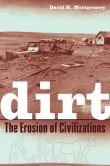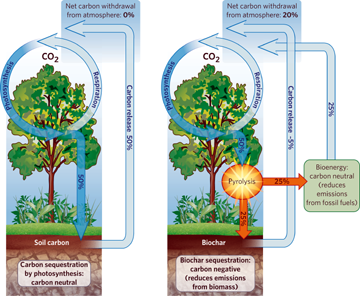New research has found that increased levels of carbon dioxide in the atmosphere cause soil microbes to produce more carbon dioxide, accelerating climate change. This research challenges our previous understanding about how carbon accumulates in soil.
Carbon Loss from Soil Accelerating Climate Change
Friday, April 25, 2014
Monday, April 21, 2014
No-Till Soil Organic Carbon Sequestration Rates Published
For the past 20 years, researchers have published soil organic carbon sequestration rates. Many of the research findings have suggested that soil organic carbon can be sequestered by simply switching from moldboard or conventional tillage systems to no-till systems. However, there is a growing body of research with evidence that no-till systems in corn and soybean rotations without cover crops, small grains, and forages may not be increasing soil organic carbon stocks at the published rates.
No-Till Soil Organic Carbon Sequestration Rates Published
No-Till Soil Organic Carbon Sequestration Rates Published
Saturday, April 19, 2014
Climate Change and Desertification a Threat to Social Stability - UN
What is of higher value than being able to feed your family? For a significant part of the global population, this means having direct access to productive land – water, soil and its biodiversity – because land is their only tangible asset.
Some 500 million small-scale farmers support the livelihoods of over 2 billion people. More than 1.5 billion people live off degrading land; at least one billion are poor. The projected climate trends threaten their livelihoods.
Coping Mechanisms Disappearing
The frequency and intensity of extreme and unpredictable weather events, especially floods and droughts that are linked to climate change, is threatening their livelihoods. It is upsetting the coping mechanisms they have relied on in bad times, robbing them not just the ability to feed their families, but their dignity as well.
By 2010, 900 million people around the world faced chronic hunger, according to the Food and Agriculture Organization of the United Nations. The latest Intergovernmental Panel on Climate Change report estimates that food demand will rise by 14 percent per decade while yields could decline by up to 2 percent per decade.
Land degradation is part of a toxic mix that is turning hungry people into vulnerable communities that are prone to instability, migration and conflict. It takes whatever underlying social weaknesses exist and magnifies them. For countries where social safety nets or alternative sources of income are lacking, underemployed and disenfranchised youth are the obvious targets of radicalization.
Let us be clear, food will be less plentiful or more expensive unless land stewardship on a global scale rises to the top of the international political agenda. In an interconnected world, a threat to food security is a threat to international security.
Climate Change and Desertification a Threat to Social Stability - UN
Some 500 million small-scale farmers support the livelihoods of over 2 billion people. More than 1.5 billion people live off degrading land; at least one billion are poor. The projected climate trends threaten their livelihoods.
Coping Mechanisms Disappearing
The frequency and intensity of extreme and unpredictable weather events, especially floods and droughts that are linked to climate change, is threatening their livelihoods. It is upsetting the coping mechanisms they have relied on in bad times, robbing them not just the ability to feed their families, but their dignity as well.
By 2010, 900 million people around the world faced chronic hunger, according to the Food and Agriculture Organization of the United Nations. The latest Intergovernmental Panel on Climate Change report estimates that food demand will rise by 14 percent per decade while yields could decline by up to 2 percent per decade.
Land degradation is part of a toxic mix that is turning hungry people into vulnerable communities that are prone to instability, migration and conflict. It takes whatever underlying social weaknesses exist and magnifies them. For countries where social safety nets or alternative sources of income are lacking, underemployed and disenfranchised youth are the obvious targets of radicalization.
Let us be clear, food will be less plentiful or more expensive unless land stewardship on a global scale rises to the top of the international political agenda. In an interconnected world, a threat to food security is a threat to international security.
Climate Change and Desertification a Threat to Social Stability - UN
Tuesday, April 15, 2014
Farming for Improved Ecosystem Services Seen as Economically Feasible
Research conducted over 25 years shows that lowering -- or avoiding -- the use of chemical fertilizers in row-crop agriculture in the northern United States can reduce polluting nitrogen runoff, mitigate greenhouse warming, and improve soils while producing good crop yields. 'No-till' agriculture provided some similar benefits. The most effective regimes required that farmers adopt more complex crop rotations, but many indicated that they would accept payments to do so, and the public seems willing to pay.
Farming for Improved Ecosystem Services Seen as Economically Feasible
Farming for Improved Ecosystem Services Seen as Economically Feasible
Nutrient-Rich Forests Absorb More Carbon
Nutrient-Rich Forests Absorb More Carbon
Sunday, April 13, 2014
Will Increased Food Production Devour Tropical Forest Lands?
As global population soars, efforts to boost food production will inevitably be focused on the world’s tropical regions. Can this agricultural transformation be achieved without destroying the remaining tropical ecosystems of Africa, South America, and Asia?
Will Increased Food Production Devour Tropical Forest Lands?
Will Increased Food Production Devour Tropical Forest Lands?
Wednesday, April 2, 2014
Doubt over the Use of Biochar to Alleviate Climate Change
In the first study of its kind, research has cast significant doubt over the use of biochar to alleviate climate change. Biochar is produced when wood is combusted at high temperatures to make bio-oil and has been proposed as a method of geoengineering. When buried in the soil, this carbon rich substance could potentially lock-up carbon and reduced greenhouse gas emissions. The global potential of biochar is considered to be large, with up to 12 percent of emissions reduced by biochar soil application.
Doubt over the Use of Biochar to Alleviate Climate Change
Doubt over the Use of Biochar to Alleviate Climate Change
Deforestation of Sandy Soils a Greater Climate Threat
A new study finds that tree removal has far greater consequences for climate change in some soils than in others, a finding that could provide key insights into which ecosystems should be managed with extra care. In a comprehensive analysis of soil collected from 11 distinct U.S. regions, from Hawaii to northern Alaska, researchers found that the extent to which deforestation disturbs underground microbial communities that regulate the loss of carbon into the atmosphere depends almost exclusively on the texture of the soil.
Deforestation of Sandy Soils a Greater Climate Threat
Deforestation of Sandy Soils a Greater Climate Threat
Subscribe to:
Comments (Atom)








